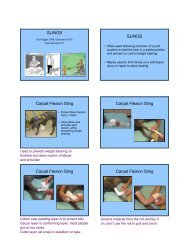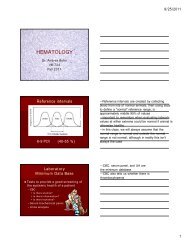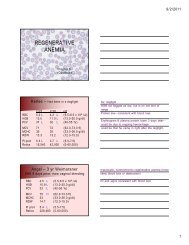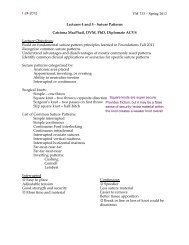Glial cells (stromal cells) Oligodendrocytes ... - CSU PVM 2014
Glial cells (stromal cells) Oligodendrocytes ... - CSU PVM 2014
Glial cells (stromal cells) Oligodendrocytes ... - CSU PVM 2014
Create successful ePaper yourself
Turn your PDF publications into a flip-book with our unique Google optimized e-Paper software.
<strong>Glial</strong> <strong>cells</strong> (<strong>stromal</strong> <strong>cells</strong>)<br />
<strong>Oligodendrocytes</strong>…gliosis/satellitosis<br />
<strong>Oligodendrocytes</strong> are present in subcortical white matter--responsible<br />
for production and maintenance of the myelin sheath<br />
If an agent damages or kills these in utero==>hypomyelogenesis (can<br />
be caused by distemper)<br />
If happens after birth (body fails to upkeep or maintain myelin):<br />
dysmyelogenesis<br />
Satellitosis = proliferation of oligodendrocytes around injured neurons<br />
Neurons cannot proliferate<br />
<strong>Oligodendrocytes</strong> produce myelin<br />
1
Astrocytes…gemistocytic/astrocytosis /Alzheimer type 2 <strong>cells</strong><br />
Astrocytic reaction is typically viewed as a reparative response in the CNS, akin to<br />
scarring in nonneural tissues.<br />
Astrocytes respond to injury by hypertrophy and limited proliferation.<br />
The section to the left is from a dog with a focally extensive area of infarction. The<br />
section is stained by GFAP (immunohistochemistry). With this particular stain you can<br />
visualize the processes (normally inconspicuous in H and E stain).<br />
Note the large number of astrocytes (hyperplasia or astrocytosis) with lot of<br />
processes (hypertrophy or astrogliosis).<br />
Fibrous have more dendrites<br />
Protoplasmic have more cytoplasm<br />
Fibrous forms glial limiting membrane<br />
Astrocytes will proliferate (astrocytosis ) and hypertrophy (astroglyosis) in<br />
response to injury to nervous tissue<br />
Protect neurons from too much electrolytes or fluid (will sacrifice self because<br />
they are replaceable and neurons are not)<br />
2
Another astrocytic response is development of visible cytoplasm. These plump active<br />
astrocytes are termed gemistocytic astrocytes.<br />
The photograph to the left is from a dog infected with CD virus<br />
Alzheimer type II <strong>cells</strong><br />
They appear as paired swollen clear astrocytic nuclei. They manifest in metabolic<br />
disturbances when the liver or kidney is damaged (hepatoencephalopathy or uremic<br />
encephlaopathy).<br />
Alzheimer II <strong>cells</strong> have no relation to the disease<br />
When astrocytes react, they hypertrophy and become more visible: look like plump<br />
<strong>cells</strong> with abundant eosinophilic cytoplasm and eccentric nuclei<br />
Called gemistocytic astrocytes<br />
Will see these in canine distemper<br />
In uremia or liver damage, see Alzheimer II <strong>cells</strong><br />
4
Brain macrophages/microglial <strong>cells</strong>…glial nodules/neuronphagia/gitter <strong>cells</strong><br />
Microgliosis refers to the proliferation of resident macrophages of the CNS<br />
(microglia).<br />
The proliferation may be diffuse or focal.<br />
<strong>Glial</strong> nodules – are hall mark of viral encephalitis<br />
Neurons are degenerating and surrounded by a proliferation of oligodendrocytes<br />
(satellitosis) and macrophages (are eating dead neurons, neuronphagia).<br />
Microglia are normally present in a resting stage until something invades the brain<br />
and activates them<br />
When activated, they proliferate and form glial nodules<br />
Surround affected neuron and eat it: neuronophagia<br />
If there is lipid turnover, glial <strong>cells</strong> will transform into Gitter <strong>cells</strong><br />
Will remove debris<br />
Now we have three types of reaction to insult: satellitosis, astrocytosis, glial nodules<br />
5
Macrophages in the CNS are either activated microglia or monocytes recruited from<br />
circulation<br />
Remember monocytes in circulation macrophages in tissues<br />
6
Inflammatory <strong>cells</strong> surround CNS vessels in the “Virchow-Robin” space giving the<br />
characteristic appearance of perivascular cuffing.<br />
Remember that there are no lymphatics in the brain.<br />
If pigs are not watered regularly especially in winter, the high salt diet with no water<br />
makes blood hypernatremic, The fluid will leave the brain to more hypertonic blood<br />
resulting in brain dehydration. When the pig subsequently drank excessive water the<br />
blood turns into hypotonic. This will result in massive flow of water back to the brain.<br />
The reason for accumulation of Eosinophils in the brain is unknown.<br />
No lymphatics in the brain<br />
Have to keep circulation in the brain unidirectional--lymphatics can't always do<br />
that<br />
Space around vessel = Virchow Robin space<br />
Inflammatory <strong>cells</strong> exit blood vessel and surround vessel in multiple rows<br />
(perivascular cuffing)<br />
Eosinophils accumulate in Virchow Robin space in salt poisoning (not known<br />
why)<br />
CHF: accumulating water around vessels which appear as clear spaces<br />
7
Status spongiosis<br />
Is a nonspecific term that describes rarefied brain parenchyma (full of holes).<br />
It can occur as a result of demyelination due to swelling of the neuropil (astrocyte<br />
and oligodendrocytes).<br />
Malacia<br />
Malacia literally means softening<br />
9
=softening of the spinal cord<br />
poliomyelomalacia would be in gray matter,<br />
leukomyelomalacia whould be in white<br />
10
Astrocytes come to fill this space = astrocytic scars<br />
Areas of liquefaction in the brain do not generally heal by fibrosis (we do not have<br />
proper C.T. in the brain except near the meninges). Typically macrophages, gitter <strong>cells</strong>)<br />
enter the area to remove the debris, leaving a cyst or cavity e.g. digestion chambers.<br />
11
The arrow are pointing to the single layer of ependymal <strong>cells</strong> that lines the brain<br />
ventricles and spinal cord central canal. VL= ventricular lumen<br />
These <strong>cells</strong> are cuboidal to columnar and are joined by tight junctions.<br />
Neoplasia can occur in the ependyma, ependymoma, which can obstruct the outflow<br />
of CSF resulting in obstructive hydrocephalus.<br />
Ependymitis may be seen with viral infections e.g. FIP in cats<br />
The lateral ventricles of the brain to the lower right are mildly dilated. FIP and<br />
resultant ependymitis along with accumulated exudate resulting in obstruction to the<br />
outflow of CSF hydrocephalus (obstructive again).<br />
One layer of tightly adhered cuboidal <strong>cells</strong><br />
Tumor of these <strong>cells</strong> might obstruct CSF flow<br />
With no room to expand, get dilation and pressure atrophy<br />
Animal will head press<br />
12
Choroid plexus forms CSF<br />
They project into lateral, third and fourth ventricles.<br />
Ependymitis? Think FIP<br />
Choroid plexitis? Think CDV<br />
Canine distemper can infect choroid plexus <strong>cells</strong> virus is shed into the ventricular<br />
system. This would spread the virus via the CSF.<br />
13
Four types of cerebral edema--know why each occurs<br />
Mostly associated with swelling and trauma<br />
First 48 hours most critical<br />
Midline shifted to right = swelling coming from left<br />
Asymmetry, left is larger<br />
15
Vasogenic: integrity of vessel is affected. No change in the forces that control<br />
blood flow<br />
Cytotoxic: astrocytes most affected. If they fail, fluid will next affect neurons.<br />
Usually occurs due to ischemia<br />
Interstitial: forces of blood are altered<br />
Osmotic: one of three organs will usually be affected--liver (no albumin), kidney<br />
(protein losing enteropathy), GI (protein losing enteropathy)<br />
Heart also can be (CHF - fluid going to third space)<br />
16
2-23-2012<br />
17
How to differentiate between edema and artifact?<br />
With edema, there will be a glial response: Alzheimer type II <strong>cells</strong>,<br />
astrocytes, etc.<br />
18
Vasogenic edema is a common complication of :<br />
- Traumatic<br />
- Inflammatory<br />
- Hemorrhagic<br />
Lesions in the CNS.<br />
So it can be seen in a variety of situations such as contusions, space occupying<br />
masses (neoplasia, abscess, hematoma and parasitic cysts). Also endotoxemia and<br />
sepsis can render CNS vessels leaky.<br />
Note the swelling and enlargement of left side this dog brain (Neoplasia).<br />
In the photograph to the right, note the reddened area of contusion on the left<br />
hemisphere. You can call this leptomeningeal hemorrhage.<br />
Affected side is swollen and gyri are flat<br />
Both trauma and edema in brain lead to energy failure and death of<br />
neurons... and you can't fix 'em<br />
19
1. e.g. space occupying lesion<br />
aa occluded by pressure = ischemia<br />
stoppage of drainage = venous obstruction<br />
2. Vitamin B1, thiamine, is<br />
important for brain function<br />
3. e.g alcohol (ethylene glycol)<br />
4. e.g. mannosidase deficiency<br />
20
The schematic depicts normal cell hydrodynamics.<br />
What happens if there is failure of the Na-K pump in the brain?<br />
More sodium accumulates inside the <strong>cells</strong> this would be followed by influx of<br />
water resulting in swelling of <strong>cells</strong>.<br />
Causes:<br />
Hypoxia-ischemia.<br />
21
An unfortunate series of events:<br />
Softened area has to be removed<br />
with Gitter <strong>cells</strong><br />
At this point, it is irreversible<br />
Replace dead neurons with<br />
asctoryces ==> astrocytic<br />
scar<br />
If, after injury, reperfuse too quickly, can have reperfusion injury<br />
22
Neurons release glutamate into synaptic cleft<br />
Astrocytes reduce glutamate to glutamine and release back into synaptic<br />
cleft<br />
Taken back up by neuron and reused<br />
NADH is important in the conversion of glutamate to glutamine<br />
With disruption to the Na/K pump, enzyme activity reduced and ammonium<br />
accumulates in the astrocyte<br />
Glutamate accumulates, exerts its excitatory effect, <strong>cells</strong> run out of energy<br />
23
eversible irreversible<br />
26
= most dangerous<br />
Take home msg:<br />
Reperfusion injury: free radicals<br />
Increased ammonium ==> decreased energy<br />
Point of free radical formation =<br />
irreversible<br />
28
Hypoxia-ischemia is one of the most common causes of cytotoxic edema.<br />
Anoxia associated with seizure activity of cardiopulmonary arrest during anesthesia.<br />
This dog suffered from cardiac arrest.<br />
29
In nonspecific cytotoxic edema, astrocytic swelling, characterized by nuclear swelling,<br />
chromatin dispersion and watery cytoplasm. <strong>Oligodendrocytes</strong>, neurons, and<br />
endothelium may also well.<br />
30
This cat has been poisoned with the rodenticide brometahlin, resulting in cytotoxic<br />
edema, particularly severe in oligodendrocytes resulting in intramyelinic edema and<br />
thus splitting of myelin sheaths. Also hexachlorophene.<br />
In the upper left, note the compact nature of normal myelin sheath in electron<br />
micrograph.<br />
In the lower photograph, the cat poisoned with bromethalin, intramyelinic edema led<br />
to splitting of the myelin.<br />
31
Water intoxication/Salt poisoning<br />
Increased body hydration caused by excessive intravenous infusions, compulsive<br />
drinking, or altered antidiuretic hormone.<br />
Increased body hydration produces hypotonic plasma and fluid moves from the<br />
plasma into the normally hypertonic brain tissue. Fluid accumulation is generally<br />
intracellular.<br />
32
gyri flattened due to<br />
increased pressure<br />
Edema may cause herniation especially in Vasogenic edema.<br />
Shaken baby<br />
As the brain enlarges, it can herniate in several places. Herniation can occur into<br />
three places.<br />
1- Cerebellar vermis herniates through the foramen magnum (also called coning or<br />
lipping of the cerebellum).<br />
2- Para hippocampal gyri beneath the tentorium cerebelli (transtentorial herniation).<br />
3- Cingulate gyrus herniation under the falx cerebri (falcine herniation).<br />
33
Hypothyroidism is most common cause of<br />
atherosclerosis in dogs<br />
possibly a parasite responsible<br />
for occlusion of brain vessels<br />
34
potential<br />
for<br />
emboli =<br />
more<br />
deleterious<br />
than stable<br />
plaque<br />
36
Dog in backyard running suddenly sits down and yelps, can't walk.<br />
Nucleus pulposis protrudes and occludes venous flow--no drainage from<br />
the corresponding part of spinal cord--venous infarct and liquefactive<br />
necrosis, malacia<br />
Usually in lumbosacral area, so hindlimbs more affected<br />
37
Vasogenic edema and dead neurons<br />
Possibly cuterebra obstructed the veins<br />
38
Right side obliterated, will have left-sided defects<br />
39
The right cerebral hemisphere is atrophied due to massive necrosis and finally<br />
collapsed.<br />
40
Not as much as a problem for monogastrics<br />
Ruminants have a & b sulfate reducing bacteria<br />
Balance between the two is important<br />
They produce two things:<br />
Hydrogen sulfide (mostly removed by eructation)<br />
Reduced sulfite<br />
Amount of Cu, Fe, Zn, CHO, fiber is important for maintaining<br />
appropriate balance between the two types of bac-t<br />
When excess sulfur ingested, favors production of the hydrogen<br />
sulfide, which is toxic (paralyzes oxidative enzymes) ==> kills neurons<br />
Also need to be careful with manure--can contain hydrogen sulfide and<br />
disturbing it leads to gas release ==> cows drop dead!<br />
42
Grey matter<br />
44
Cortex damage, white matter OK<br />
Weakness, blindness, lateral recumbency, paddling with feet<br />
Either thiamine deficiency or sulfate excess can cause this<br />
Dx: between the two--thiamine deficiency fluoresces under wood's lamp<br />
45
= thiamine deficiency<br />
47
left<br />
subdural hemorrhage<br />
48
hematoma = circumscribed<br />
collection of blood<br />
most dangerous<br />
50
often not too<br />
horrible<br />
can't do much<br />
surgery here<br />
worst type - near vital structures,<br />
e.g hypothalamus<br />
51
Repeated trauma results in brain swelling<br />
associated with apoptosis!<br />
52
Instantaneous death in horses caused by rearing -- basisphenoid bone<br />
lacerates vessels to brain -- huge hemorrhage smooshes all that<br />
important stuff in the brain stem<br />
53
will see large hemorrhage<br />
55
espiratory center, etc affected<br />
56
Brain ricochets off opposite side of skull<br />
58
2-27-2012<br />
Hansen Type I<br />
Hansen Type II<br />
59
spinal segments subjected to sudden trauma--adjacent structures<br />
overlay each other--massive necrosis of neurons<br />
or<br />
e.g. car accident<br />
60
HBC, lots of hemorrhage<br />
61
Common in older animals<br />
Health of IVD can't be maintained, so it protrudes and starts impinging on<br />
spinal cord with increasing severity<br />
Instead of vasogenic edema, hemorrhage, necrosis in both grey and white<br />
matter (like you would see with fast spinal cord damage), have Wallerian<br />
degeneration in white matter only. Will see digestion chambers on histo.<br />
63






